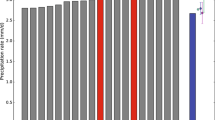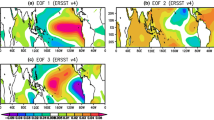Abstract
An evaluation is carried out of the moisture fields, the precipitation P and evaporation E, and the moisture transport and divergence in the atmosphere from the global atmospheric National Centers for Environmental Prediction (NCEP)–NCAR reanalyses produced with four-dimensional-data assimilation. The moisture fields are summarized by the precipitable water which is compared with analyzed fields from NVAP based primarily on Special Sensor Microwave Imager (SSM/I) over the oceans and rawinsonde measurements over land, plus TIROS Operational Vertical Sounder (TOVS). The moisture budgets are evaluated through computation of the freshwater flux at the surface E−P from the divergence of the total moisture transport, and this is compared with the reanalysis E−P that is based upon a 6-hour integration of the assimilating model and thus depends on the model parametrizations. The P field is evaluated using Xie– Arkin global precipitation estimates which, although containing considerable uncertainties, are believed to be reliable and good enough to show that there are substantial biases in the NCEP P. There are many fields of interest and which are improved over previous information available. On an annual mean basis the largest evaporation of over 6 mm/day is in the subtropical Indian Ocean. However, the NCEP moisture fields are shown to contain large and significant biases in the tropics. The tropical structures are less well defined and values are generally smaller where they should be high and higher where they should be low. In addition, the NCEP moisture fields contain less variability from year to year. The NCEP model P generally reveals a double intertropical convergence zone in the central Pacific and the location of the South Pacific Convergence Zone is not well captured. Rainfall amounts are lower than observed in the oceanic tropical convergence zones. The variability in the central tropical Pacific of P associated with El Niño-Southern Oscillation (ENSO) is underestimated in the NCEP reanalyses and, moreover, is not very well correlated with the Xie–Arkin product. A bias for too much rainfall in the model over the southeastern USA and southeast Asia is also present in northern summer. The comparison of E−P from the moisture budget with the model results reveal some strong systematic differences. In particular, remarkably, many island stations show up as bull’s-eyes in the difference field. These are identified as originating from small but systematic differences in vertical moisture profiles from those in the surrounding oceans, raising questions about the influence radius of rawinsonde moisture observations. Biases in E are inferred from the E−P differences in some places implying some spurious land moisture sources. While usually better, the residual method E−P estimates are inferior to those from the model parametrizations in some places. Both estimates are affected by biases in moisture, as analyzed, and the moisture divergence depends critically on the velocity divergence field. The model estimates also depend upon the parametrizations of subgrid scale processes, such as convection, that influence E and P. A discussion is given of sources of errors contributing to the moisture budgets.
Similar content being viewed by others
Author information
Authors and Affiliations
Additional information
Received: 28 October 1996/Accepted: 11 September 1997
Rights and permissions
About this article
Cite this article
Trenberth, K., Guillemot, C. Evaluation of the atmospheric moisture and hydrological cycle in the NCEP/NCAR reanalyses. Climate Dynamics 14, 213–231 (1998). https://doi.org/10.1007/s003820050219
Issue Date:
DOI: https://doi.org/10.1007/s003820050219




